What is a Pentacle or Pentagram?
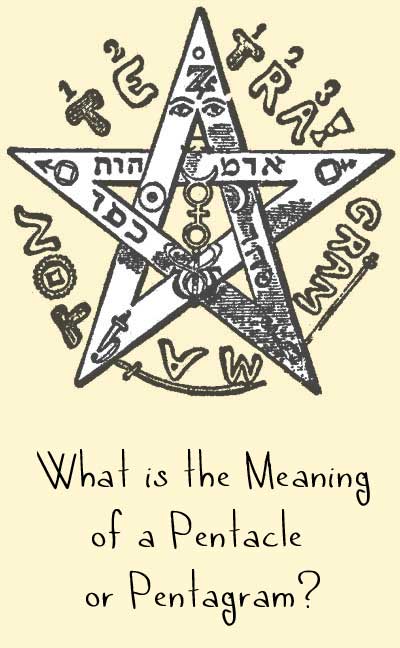 The pentagram is an ancient symbol used by many cultures and has been around since the Stone Age (the time before humans started using metal to make tools). It is also one of the most misunderstood symbols.
The pentagram is an ancient symbol used by many cultures and has been around since the Stone Age (the time before humans started using metal to make tools). It is also one of the most misunderstood symbols.
Today, when we see a pentagram, we immediately have images come to mind involving such things as Satanic rituals and sacrifices, evil spells or the invocation of demons or evil spirits from other realms. But, did you know that the pentagram was once one of the main symbols of Christianity and was more widely used by Christians than the cross?
There is more to the Pentagram than you think.
Before you think to yourself that the pentagram must surely be a symbol of evil, consider these other ways which it has been used throughout history; it just might change the way you see it:
- It has been a sign of royalty, meaning that the power of those in rule will spread to the four corners of the world.
- It has been a symbol of protection against evil and has been worn by people and placed over the doorways and windows of their homes.
- It represented the five virtues of knighthood, "generosity, courtesy, chastity, chivalry, and piety".
- Pythagoras, the famous Greek mathematician and philosopher, thought of it as a symbol of the perfection of man.
- To the Egyptians, it represented the underground womb from which all living things are reborn.
- To this day, Gypsies still cut an apple horizontally to reveal a pentagram inside, which they call the "Star of Knowledge".
So you see, for most of history, all the way from the Stone Age, the pentagram has been a symbol of good things. Its association with evil is only a recent development and began mostly with one man's opinion, and later, its use by Hollywood to create shock value in their horror movies.
Of course, any symbol is meaningless in and of itself - it only has the meanings that we give it, both as individuals and as a group.
Let's try to understand it a little bit more.
In light of that, let me take you on a journey back to the beginning, because the pentagram is an important and widely used symbol and we can't really understand what it means without knowing a little bit about its origins. (Don't worry, I'll try not to sound like a history book.)
But before I dive into the history of the pentagram, let me give you a bird's eye view of its modern meaning.
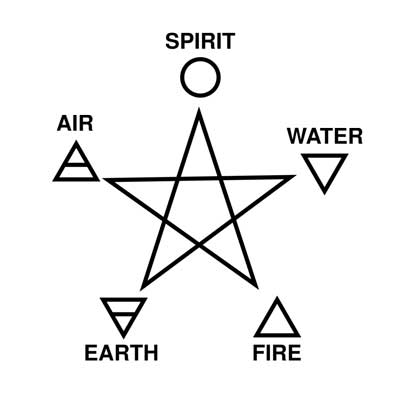
Modern meanings
The word "pentagram" comes from the Greek word "pente" (meaning "five") and "graphein" (meaning "to write"). So, the word "pentagram" means a 5-pointed star or any figure made of five lines.
Today, the pentagram is generally known to be a symbol of the earth-based faiths of Wiccans and Neopagans. It symbolizes the four elements of earth, air, fire and water, along with the element of spirit on top, meaning that the four elements are ruled by the spirit, or the idea of "mind over matter".
It is also a symbol of the number 5 as a mystical and sacred number that is inherently natural and human, since it is found in many life forms. The five-way symmetry of the pentagram can be found in starfish, flowers, the human hand and body and many other living things.
 This pattern of five exists down to the level of molecules and therefore represents not just the natural life forms we see, but also the very foundations of their being. In this way, the number five is the essence of life.
This pattern of five exists down to the level of molecules and therefore represents not just the natural life forms we see, but also the very foundations of their being. In this way, the number five is the essence of life.
The pentagram is also a symbol of protection against evil because it is made of 5 outward-pointing spikes that protect a womb-like center.
And finally, wearing a pentagram means that you feel a connection with the elements and respect for the earth.
When there is a star with a circle around it, it is often called a pentacle, with the circle symbolizing the idea of infinity, the cycles of life and a connection between all five elements. Adding the circle symbol is the main difference between the pentacle and pentagram.
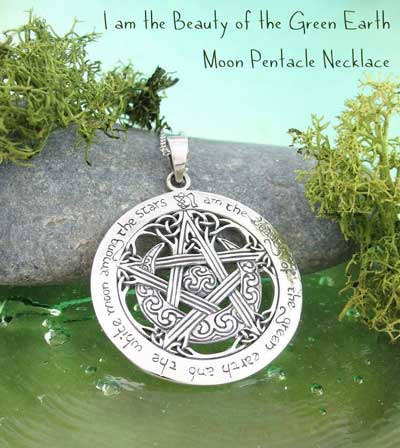
And now, let's take a bit of a deeper look at the pentagram's history so that we can better understand what it means and how it came to be.
Pentagrams in Ancient History
The very earliest pentagrams were crude diagrams scratched into the walls of Neolithic Stone Age caves. It's not known what the pentagram meant to these primitive people.
In texts from Sumeria (one of the first civilizations in the world, from around 3000 BC to 2600 BC), the pentagram symbolized the four directions and a fifth direction, "above", and the five visible planets.
As a symbol of the goddess Kore
A goddess named Kore was worshipped in many countries thousands of years ago in an area that ranged from modern-day England to Egypt. Her sacred fruit was the apple.
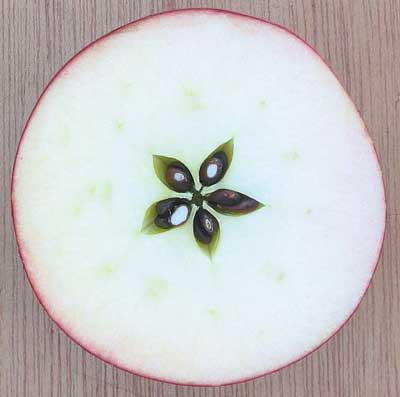 When you cut an apple horizontally, through its "equator", you'll find a nearly perfect, five-pointed star created by the spaces containing the seeds. Wiccans, Neopagans and Gypsies still cut an apple this way to reveal the star inside. This apple-pentagram is known to the Gypsies as the "Star of Knowledge".
When you cut an apple horizontally, through its "equator", you'll find a nearly perfect, five-pointed star created by the spaces containing the seeds. Wiccans, Neopagans and Gypsies still cut an apple this way to reveal the star inside. This apple-pentagram is known to the Gypsies as the "Star of Knowledge".
During the 4th century AD, Kore was worshipped by the Coptic Gnostic Christian religion in Alexandria, Egypt. Her festival, called Koreion, was held on January 6th and was adopted by the Christian Church as the Feast of Epiphany, a.k.a. Little Christmas or Three Kings Day.
This feast day is a time when Christians remember when the Wise Men (also known as the Three Kings or the Magi), visited the baby Jesus and brought gifts of gold, frankincense and myrrh.
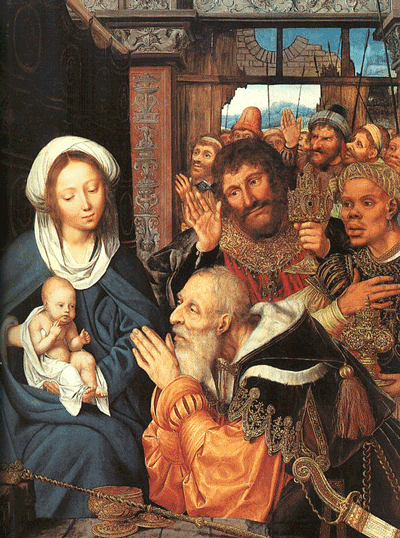
In Hebrew Scriptures (or the "Old Testament")
The pentagram was the first and most important of the Seven Seals, an amulet whose seals represented the seven secret names of God.
Also, each point of the pentagram symbolized the five books of the Pentateuch, which are the first five books of the Bible, also known as the Torah.
Pythagoras
Pythagoras was an ancient Greek philosopher, teacher and leader known for his knowledge of mathematics, music, astronomy and sacred geometry.
Early in his life, he traveled the world, gaining access to and absorbing the secret traditions, esoteric knowledge and mysteries of many cultures. When he returned from his travels, he set up a school to teach a small number of devoted students this secret knowledge, along with the fundamentals of occult music, mathematics and astronomy.
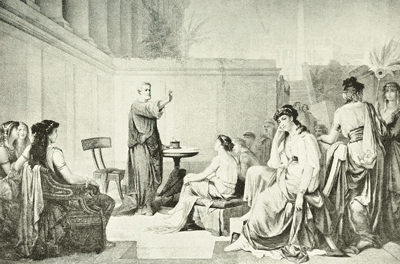
Because of his intellectual brilliance and outspoken nature, he attracted political and personal enemies who eventually attacked and burned his school, forcing his teachings and his students underground.
During this time of persecution, followers of Pythagoras used the pentagram as their secret symbol, "so that they may know each other".
The pentagram was significant to the Pythagoreans for a number of reasons. It was seen as a sacred symbol of divine perfection and also as a symbol of man because of the five-way symmetry of the human body. 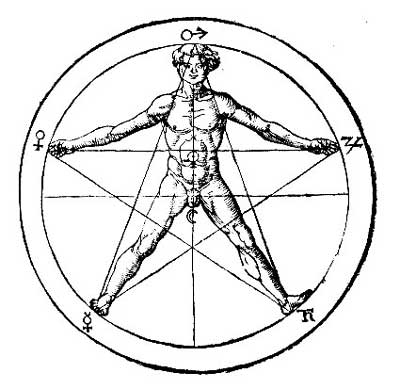 Furthermore, each of the five points of the star represented the five elements that make up man:
Furthermore, each of the five points of the star represented the five elements that make up man:
- fire = energy
- water = fluid
- air = breath
- earth = matter
- psyche = mind
Pythagoreans also held the pentagram sacred to Hygeia, the Greek goddess of health and hygiene and greeted each other with "Be sound / whole / blessed!" (Hugiaine!).
And lastly, Pythagoreans called the pentagram, the "Pentalpha", because it was made of five interlaced, perfect As or Alphas, and was a symbol of the individual as part of a whole.
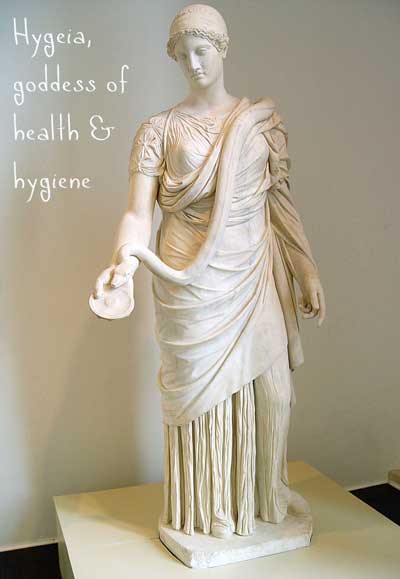
After the teachings of Pythagoras were forced underground, the schools secretly continued on and from them came the Mystery Schools and Masonic Guilds (groups of expert stone masons who were initiated into the teachings of the Mystery Schools).
The Christian Church felt that the Masons were quite heretical, yet hired them to design and build the great cathedrals of Europe. The Masons subsequently incorporated their symbols into architecture, as pentagrams and five-fold designs can be found on the facades and also by plotting certain points on the floor plans of various cathedrals.
The Mystery Schools and Masonic Guilds held onto the pentagram as part of their symbolism, where it keeps its positive, ancient meanings and is a symbol of of secret, enlightened knowledge.
Because the divine knowledge of these groups threatened the power of the Church, those who pursued it or used its symbols were oppressed and mistreated.
This was one of the reasons why the pentagram, which was originally a symbol of perfection and divine knowledge, became stigmatized, because the Church framed it as a symbol of heresy. Because of this influence, it eventually came to have associations with evil.

The Christian pentagram
It is a curious thing that the pentagram is generally thought of as evil by fundamental Christians because it was actually one of the main symbols of Christianity before the cross came into popular use.
In the Middle Ages, Christians used the pentagram to represent the five wounds of Christ - 2 on the wrists, 2 on the ankles and one on the side. The photo of the red star inside a circle with a cross comes from the church of Our Lady of Victory in Marble Cliff, Ohio.
Furthermore, according to some scholars, it represented the Star of Bethlehem, which led the Three Wise Men to the baby Jesus. In this form, the pentagram represents salvation and the Holy Spirit descending to earth.
And since the pentagram can be drawn entirely in one stroke, without lifting one's pen, it was said to represent the Alpha and the Omega, or Christ himself.
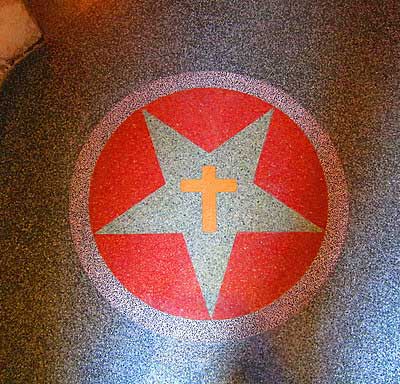 Many King Arthur stories have Christian influences. In the story "Sir Gawain and the Green Knight", Sir Gawain, who is King Arthur's nephew, adopts the pentagram as his personal symbol, both wearing it on his coat and displaying it on his shield. It was gold on a red background and represented the five knightly virtues of "generosity, courtesy, chastity, chivalry and piety". ("Sir Gawain and the Green Knight, Line 663)
Many King Arthur stories have Christian influences. In the story "Sir Gawain and the Green Knight", Sir Gawain, who is King Arthur's nephew, adopts the pentagram as his personal symbol, both wearing it on his coat and displaying it on his shield. It was gold on a red background and represented the five knightly virtues of "generosity, courtesy, chastity, chivalry and piety". ("Sir Gawain and the Green Knight, Line 663)
Furthermore, the pentagram was widely used by past Christians as a protective amulet, thought to ward off witches and demons. It was sometimes found carved above doors and windows or on cribs, to protect babies from harm.
As you can see, the pentagram actually had a long and varied history of use by Pagans, Judeo-Christians, Freemasons and many other groups and was always a positive symbol that represented knowledge, perfection, divinity, the triumph of the spirit, goodness and virtue.
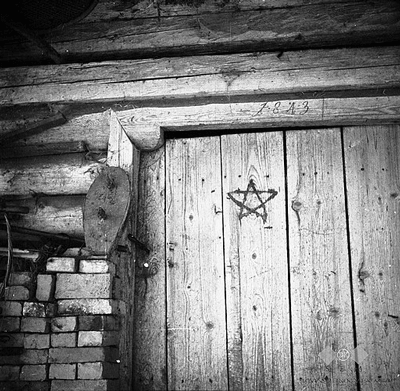
Association with Evil
While the Church had slowly been shifting the public perception of the pentagram as being evil, it wasn't until the year 1855 that a negative association was actually recorded in a text by the French priest and occultist names Eliphas Levi.
He published two books called "The Dogma and Ritual of Transcendental Magic", and was the first person to give a negative meaning to the inverted pentagram.
Since the Renaissance, the five elements of ancient Greece were associated with the five points of the pentagram, with the element of "spirit" at the uppermost point of an upright pentagram. This symbol represented the idea of "mind over matter", meaning that your mind has control over your base instincts or carnal desires.
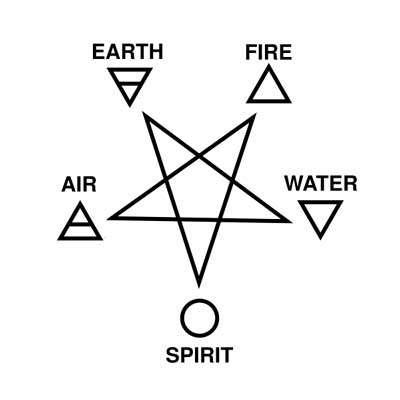 Levi felt that the inverted pentagram (with two points facing upwards), should be a symbol of evil because it inverted what he saw as the natural order. It was a symbol of "matter over spirit", meaning that your base instincts and carnal desires take precedence over the better judgement of your mind.
Levi felt that the inverted pentagram (with two points facing upwards), should be a symbol of evil because it inverted what he saw as the natural order. It was a symbol of "matter over spirit", meaning that your base instincts and carnal desires take precedence over the better judgement of your mind.
He is also credited with associating the head of the goat with the inverted pentagram.
Before this, there was no other work, religious, occult or popular, that associated the pentagram with negative meanings. In this way, his book was the beginning of the pentagram being seen as an evil symbol.
Where was the Pentagram NOT found?
To better understand these misconceptions, it's important to note where the pentagram is NOT found:
- Around the years 1450-1700, there were the Great Witch Hunts in Europe, when tens of thousands of innocent people were accused by the Christian Church of witchcraft or devil worship and were tortured, hung, or burned alive. None of the books that were used by witch hunters to identify witches or their rituals contained a pentagram or even mentioned it.
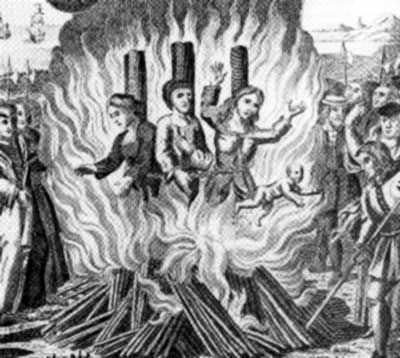
- Books like the Malleus Maleficarum or the Compendium Maleficarum, which gave detailed descriptions of witches' powers, poisons and dealings with the Devil, never mention the pentagram.
- In King James' Daemonologie, a book written in 1597 about the practices of black magic, the study of demonology, and other topics like werewolves and vampires, there is again no mention of the pentagram.
- Beyond these important works, there were many others on the topics of witchcraft, sorcery, and their trials that never mention the pentagram.
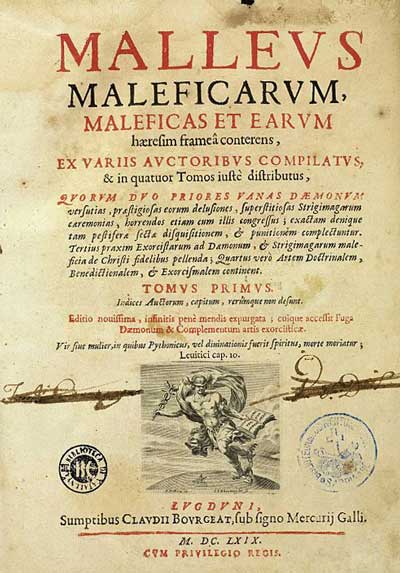
Hollywood Horror Movies
In the mid-1900s, Hollywood adopted the pentagram as a symbol of evil magic and devil worship. They used it in all kinds of horror movies involving things like demonic possession, seances, exorcisms, sacrifices and more.
If you'd like to see the way that Hollywood has abused this symbol, simply type "pentagram horror movie" into Google and search the images.
The film industry has a great influence, not just on our symbols, but on many of the thoughts and values that we likely take for granted. For instance, just think about Hollywood's influence on our body image or even all the actors who have been voted into public offices, likely because we feel like we "know them" (think of Ronald Reagan, Clint Eastwood, Sonny Bono, Jesse Ventura, Arnold Schwarznegger, and Donald Trump).
To this day, the pentagram continues to be misused and stigmatized by Hollywood and media as an easy way to create cheap shock value.
Is a pentagram Satanic?
In the 1960s, the Church of Satan adopted the Sigil of Baphomet as their official seal. The design features the "Sabbatic Goat" or the "Goat of Mendes" inside an inverted pentagram and surrounded with a circle and Hebrew letters at each of the five points, spelling the word "Leviathan". 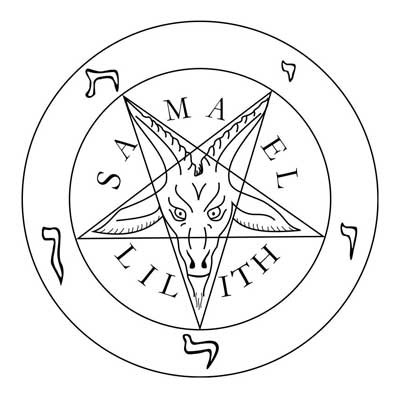
To a Satanist, the symbol represents the idea of man as "a carnal beast, living in a cosmos that is indifferent to our existence". The Church of Satan believes in the choice of the individual to pursue his own desires rather than surrender himself to a god or religious dogma; it is, in essence, a deification of the individual.
It is a religion that embraces one's autonomy and the idea that man is a carnal creature by nature.
Beyond it being a symbol of Satanism, the Baphomet pentagram doesn't really have any other meaning.
Even though they use similar symbols, Satanists and Wiccans have different belief systems and really have nothing to do with each other.
Modern Day Wicca
The pentagram is the main symbol of Wicca, an earth-centered spirituality or way of life. It's gods and symbols have Celtic roots and their celebration days follow the cycles of the Sun and Moon.
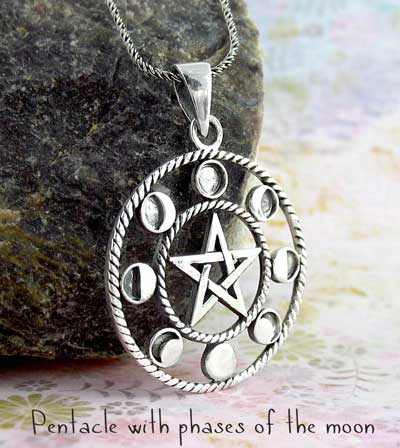 The Wiccan Rede is an expression of the main moral system of Wicca and it states "An it harm none, do what ye will", which simply means to do what you like, as long as it doesn't harm anyone.
The Wiccan Rede is an expression of the main moral system of Wicca and it states "An it harm none, do what ye will", which simply means to do what you like, as long as it doesn't harm anyone.
In Wicca, the pentagram does not represent good or evil, it is simply a symbol of their faith. The five points represent the five elements of earth, water, fire, air and spirit.
The pentagram is often placed within a circle that contains and connects all of the elements. The circle also represents ideas of eternity, infinity, the universe and the cycles of life and nature.
Wiccans do not consider the pentagram to be good or bad, no matter which way it is facing. With the single point up, it represents the spirit ascending over matter. With the single point down, it represents the spirit descending into matter and is used for what are called "second degree initiations", when one turns their spiritual path inward.
This is a time when a Wiccan turns to face and gain control over their own base emotions (fear, ignorance, prejudices, etc.), so that they can develop mastery over themselves.
 Wiccans use the pentagram to identify each other, in their altars, sacred art and rituals. Different practitioners and groups have different meanings and uses for the pentagram.
Wiccans use the pentagram to identify each other, in their altars, sacred art and rituals. Different practitioners and groups have different meanings and uses for the pentagram.
During rituals, Wiccans often draw a pentagram in the air as a way of invoking or banishing certain energies. The pentagram invokes or banishes depending on the direction in which it is drawn.
Use in the U.S. Government
The pentagram plays an important role in many of the symbols of the U.S. Government. Several of the founding fathers were Freemasons (George Washington, Benjamin Franklin and James Monroe) and it is thought that they wove Masonic symbols, like the pentagram, into American society - in particular, the national seals, the U.S. Flag, streets in Washington D.C., architecture and the dollar bill.
In the U.S. Capitol, the White House sits at the point of a giant pentagram formed by the streets. The Great Star Flag of 1837 was made of 26 upright stars in the shape of an inverted pentagram.
 The Texas Rangers and other law enforcement agencies of the Old West used pentagrams in their badges. The Pentagon, headquarters of the U.S. Department of Defense, is shaped like the center of a pentagram.
The Texas Rangers and other law enforcement agencies of the Old West used pentagrams in their badges. The Pentagon, headquarters of the U.S. Department of Defense, is shaped like the center of a pentagram.
The Medal of Honor, America's highest and most prestigious military award, given to service members for acts of great bravery, is an inverted pentagram.
A few notes on the Upright vs. the Inverted Pentagram
People tend to think that the inverted pentagram is an evil symbol, but historically, it has been shown both ways and the ancients rarely made any distinction between the two. Even today, an upside-down star is not necessarily a Satanic symbol and is just as likely to be Wiccan or Masonic.
In Conclusion
As you can see, the pentagram has had a long and varied history across many different cultures and belief systems and has mostly been a symbol of good.
What's important to keep in mind is that the meaning of every symbol is always changing - it changes because of the meanings we give to it and the way we choose to use it.
Does the pentagram have special meaning for you? Let me know in the comments below!
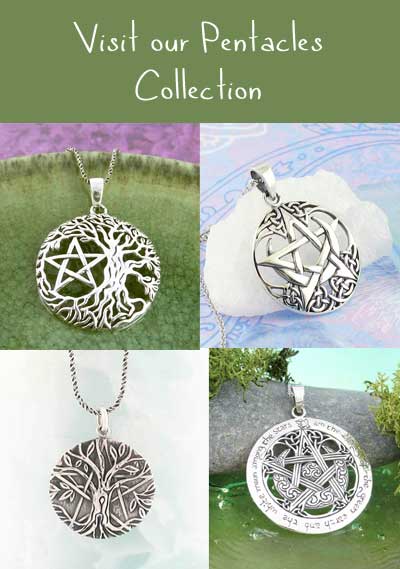
This article is brought to you by Woot & Hammy - "Our mission is to be a place for Wiccans, Pagans, and others to find affordable, high-quality jewelry that will help them express themselves and their beliefs, and by doing so, help to expand awareness and acceptance of them and their communities." Click here to visit our site.
Links to photo credits: Okra; Five-petaled flower; Starfish; Apple cut in half; Hygeia; Cathedral window; Masonic temple; Red pentagram w/ cross; Carved pentagram on door; Pentagram w/ candles - by Kam Abbott; Wiccan altar, license; "The Pentagon" [https://flic.kr/p/4m7mNY] by David B. Gleason is licensed under CC BY-SA 2.0 [https://creativecommons.org/licenses/by-sa/2.0/]; Medal of Honor, by Insomnia Cured Here, license
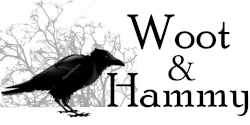


215 Comments
SUvWhPrLIKaOV
ZeXVnvYWCUiwI
eERIUmdAWP
oHMYyFsqwGuaL
egkqwtaKdQT